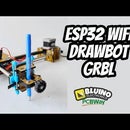Introduction: How to Make Bluetooth Shields for Upload Sketch to Arduino
You can upload a sketch to Arduino from android or pc over bluetooth, to do it you need some little additional component such as bluetooth module, capacitor, resistor, beardboard and jumper wires then you hook up together and connect to Arduino pin. But sometime having trouble with loose wire connection, do mistakes when connecting. A good solution for this problem is to make it be a shield.
By adding additional components such as leds, buzzer, RGB led, buttons, sensors etc. You can make this into a shield bluetooth to upload a sketch with some components for basic training starter kit, I am going to show you how you can make it.
Step 1: Tools That You Will Need
Here are the tools that you will need to make this project.
Tools:
- (1) Soldering Iron and Lead
- (1) Wire Cutter
- (1) Needle Nose Pliers
- (1) Wire Strippers
- (1) Helphand tool
(1) Saw/Cutter for cutting PCB (not defined on image)
Step 2: Components That You Will Need
Here are the components that you will need to make this project.
Components:
- (1) Module Bluetooth HC05
- (1) Double layer Protoboard 6cm x 8cm
- (1) Trimpot with knob 10k ohm
- (4) Led 5mm
- (1) RGB led 10mm common cathode
- (1) Buzzer 5v
- (7) Resistor 1k ohm 1/4w
- (1) Capacitor 1uf/16v
- (4) Button switch 2 pin
- (1) Temperature sensor TMP36 (not defined on image)
- (1) Female header - right angle 6pin (socket bluetooth)
- Female header: 10pin (1), 8pin (2), 6pin (1).
- Male header: 10pin (1), 8pin (2), 6pin (1).
- Some core of cable (jumper from pin to pin on protoboard)
- Jumper wire (jumper for long distance)
Step 3: Schematic and Wiring
Attachments
Step 4: Let's Get Started
Most kinds of circuit boards will work for making a shield. The easiest kind of boards to use are double sided circuit boards. These have etching on both sides. This lets you make your connections on either side to suit whatever works best for your design. If you do not have access to double sided circuit boards, it is often possible to take two one sided circuit boards and mount them back to back. This will let you make connections on either side but it does take up a lot more space. I personally prefer to use plain perf boards because they let you make all the connections yourself.
Cut the PCB into dimensions remaining 20 holes, to cut the PCB you can use a sharp knife, but I would rather suggest a saw as it be faster.
Step 5: Make a Shield Header Pins Match With Arduino Pins
You just need to make one modification to the header pins before you can solder them to the circuit board. Most of the pin holes on the Arduino have the standard 0.1 inch spacing between each hole. However, this is not true of the spacing between pins 7 and 8. This spacing is slightly smaller. To compensate for this, you need to bend each of the pins slightly. By bending the pins you can make the tops match up with the standard 0.1 inch spacing on the perf board and the bottoms match up with the smaller spacing on the Arduino. For male header pins, you will want to bend the tops of each pin. For stacking header pins you will want to bend the bottoms of each pin. To ensure that everything lines up properly, I recommend inserting the pins into the Arduino before soldering.
Step 6: Assembling Components
To assembly each component to pcb you can follow picture to get right position, then solder all legs of component on pcb. I used one piece of cable core to make connection between legs of component to other or to arduino pin header. The first test wire connections i made is as in the picture, use one piece of cable core, bend it and solder it to follow the desired path.
Step 7: Soldering Female Header Pins
Female header pin is an additional component, if you want this shield look simple you do not have to install female header pin. In this shield some pins already connected with components like leds, buttons, buzzer etc, but if you still want to use other pins that are still free (D2, D8, D12, D13, VCC and GND), you can soldering female header pin. Before installing female header pin should make the connecting jumper as shown in picture.
Step 8: Create a Wire Connection Path
After you have finished soldering all the components, to make your shield done the last step is to make the connecting wire follow the red path as in the picture with reference to the schematic in step 3. To jumper a fairly far point using cable.
Step 9: Finished
You are done!
Before using shield you must first set HC05 bluetooth module follow this instructable: https://www.instructables.com/id/Program-Your-Arduino-With-an-Android-Device-Over-B/
That´s how simple it is to make Bluetooth Shields for upload sketch to Arduino.
Now we should be ready to use the shield.
You can try/play this shield with App installed from google play to learning Arduino basic and upload sketch from Android using Bluino Loader App.
https://play.google.com/store/apps/dev?id=7460940026245372887
Thanks for your attention!
I hope you like this Instructables. If you have any questions share them in the comments and I will answer them as soon as possible.

Participated in the
Arduino Contest 2017














